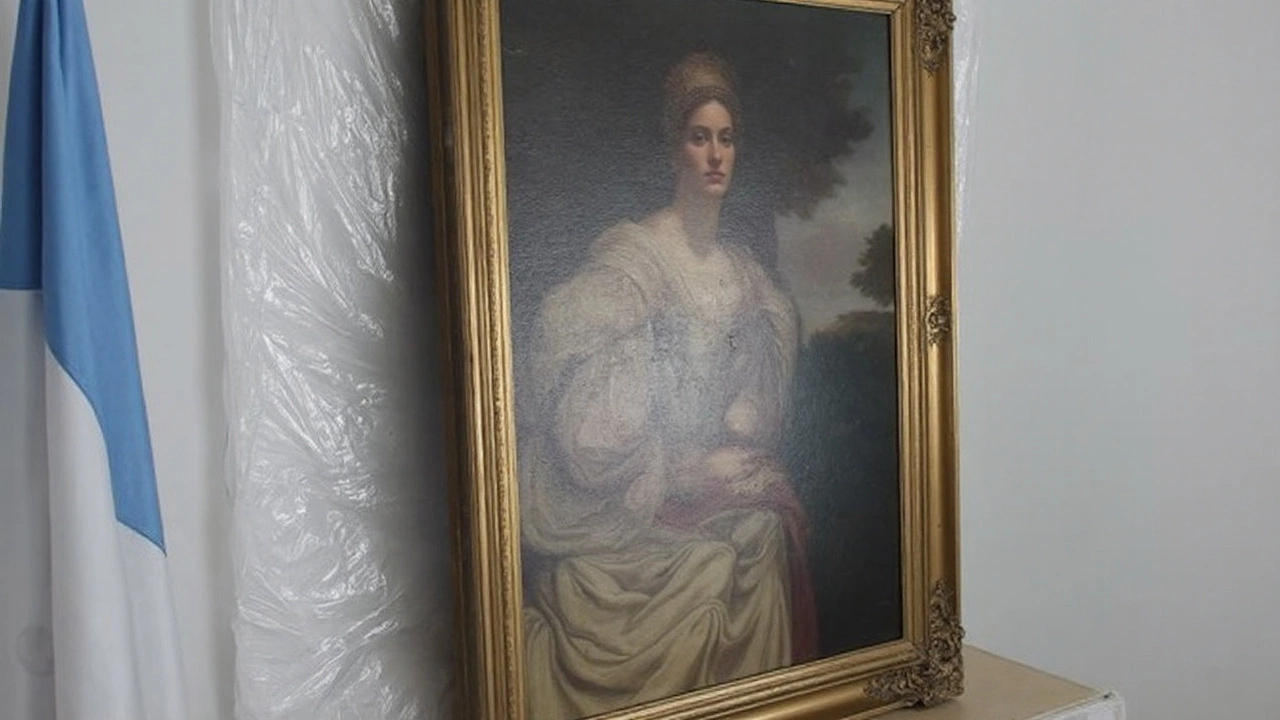An Italian Baroque portrait resurfaces in Argentina
After eight decades off the radar, an 18th-century portrait has resurfaced in Argentina, filling in one more piece of a long, painful puzzle. Argentine authorities unveiled a 1710 painting titled \"Portrait of a Lady\" by Italian artist Giuseppe Ghislandi in the coastal city of Mar del Plata, confirming it was stolen by the Nazis from the collection of Dutch Jewish art dealer Jacques Goudstikker during World War II.
The recovery began in an unusual way. Dutch journalists, browsing a real estate listing, spotted the portrait hanging on a wall. The ad was posted by Patricia Kadgien, whose father, Friedrich Kadgien, served as a finance official under the Nazi regime before fleeing to Argentina after the war. Their tip set off a chain of calls and checks across borders that ultimately led Argentine police to the address.
When officers first visited the home, the painting was no longer on the wall. Authorities placed Patricia Kadgien under house arrest while they continued to search. The breakthrough came when the family’s lawyer agreed to hand the work over to investigators. At a press event, art historian Ariel Bassano said the canvas was in solid condition for its age and estimated its value at about $50,000. The portrait, displayed in an oversized gilded frame, now sits in state custody while paperwork and provenance reviews run their course.
The work itself fits squarely within Ghislandi’s world. Born in Bergamo in 1655 and better known as Fra Galgario, he built a career on sharp, psychologically tuned portraits. He favored real people over ideal figures, dressing them in the lived-in fabrics and textures of their time. \"Portrait of a Lady\" carries that signature look — a poised sitter, careful lighting, and quiet detail that tells you as much about status and mood as it does about fashion.
Even so, the art here is only half the story. The other half is the journey — from a leading Dutch dealer’s gallery to Nazi hands, into private walls far from Europe, and finally back into public view. That path mirrors what happened to thousands of artworks between 1933 and 1945, when Nazi agencies and collaborators stripped Jewish collectors and dealers of their assets by force, coercion, and sham sales.

A window into the shadow market of Nazi plunder
Goudstikker’s name is central to the history of looted art. He was one of the Netherlands’ most prominent dealers before the war. In May 1940, while fleeing the Nazi invasion, he died in an accident aboard a ship on the North Sea. In the months that followed, Nazi officials orchestrated the forced takeover of his inventory. The seizure and sale of that collection — more than a thousand works — became one of Europe’s emblematic cases of cultural theft.
Over the decades, hundreds of pieces once owned by Goudstikker have been identified and returned, but many are still unaccounted for. Authorities say they found other paintings during their search in Argentina and are now reviewing those works as well to see if any share the same dark history.
Recoveries like this rarely happen by chance. They rely on patient provenance research, cross-border cooperation, and tips that surface in unexpected places — an auction catalog, a museum label, an online listing for a home. Once a lead appears, investigators move to secure the artwork, verify the chain of ownership, and connect with the families or estates of those who lost it. International norms, shaped by postwar restitution efforts and guidelines such as the Washington Principles, encourage institutions and governments to resolve claims fairly and transparently, even decades later.
Argentina has its own chapter in this story. After World War II, the country became a destination for former Nazi officials and collaborators, a migration that left a long tail of artifacts and art hidden in attics, storage rooms, and private collections. From time to time, these items surface — in police raids, estate sales, or, as in this case, a real estate ad. Each discovery triggers a familiar sequence: secure the object, examine its history, and determine who has a rightful claim.
Here is how the latest case unfolded, according to officials and researchers involved in the recovery:
- Dutch journalists spotted Ghislandi’s \"Portrait of a Lady\" in photos attached to an Argentine real estate listing.
- They alerted authorities and art researchers with experience tracing World War II losses.
- Argentine police visited the listed property but found the painting had been removed.
- Patricia Kadgien was placed under house arrest as investigators continued their search.
- The family’s lawyer then turned the painting over voluntarily to authorities.
- The work was presented publicly in Mar del Plata and placed under state custody for evaluation and case processing.
What happens next? Several steps typically follow a seizure like this:
- Condition and authentication checks: Experts assess the canvas, frame, and any alterations.
- Provenance review: Researchers compare records from the Goudstikker collection with wartime and postwar documentation.
- Legal review: Authorities coordinate with counterparts in the Netherlands and with representatives of the original owner’s estate.
- Restitution process: If the link is confirmed, the work is prepared for return to the rightful owners or their heirs.
- Public disclosure: Results are usually made public to support transparency and help locate other missing works.
The price tag attached to this recovery — around $50,000 — is modest by the standards of blue-chip Old Masters. But value is not the point. For families and researchers, each return closes a gap in the historical record. It also eases the burden on museums, dealers, and private owners who want to know if the paintings on their walls carry any unsettled claims.
Scale matters, too. Historians estimate that the Nazis and their collaborators stole or forced the sale of hundreds of thousands of artworks across Europe between 1933 and 1945. Many were dispersed through clandestine sales or traded repeatedly, obscuring their past. That is why even today, curators scour handwritten ledgers, export permits, gallery stamps, and customs records. One line in a ledger can match a work to a wartime inventory and unlock a claim that has been dormant for generations.
Ghislandi’s canvas now joins a growing list of works recovered far from where they were taken. Some resurface in small towns, others in major markets. Sometimes they hang openly for years, unnoticed. Other times they are hidden away. In every case, the paper trail — the documented path from artist to present day — is the key. Where the paper trail breaks, specialists step in to rebuild it, one document at a time.
There is also a broader cultural effect. Recoveries like this prompt owners, heirs, and institutions to take a second look at what they hold. They encourage due diligence before a purchase and proactive reviews of older collections. And they remind the public that art is not just an object with a price; it is a record of people’s lives — their ambitions, their losses, their survival.
For now, \"Portrait of a Lady\" is evidence in an active case and a symbol of persistence in the search for justice. It traveled from an Italian studio in 1710 to a Dutch dealer’s inventory, into the machinery of Nazi theft, and eventually to a private wall in Argentina. Thanks to a tip, careful police work, and the slow grind of provenance research, it is back in the light. The hope among researchers is simple: that this recovery will spark fresh leads, help identify other works still missing from the Goudstikker collection, and bring more families one step closer to closure.
And the term that sums up the stakes here matters: this is Nazi-looted art, and every verified recovery is not just a headline — it is proof that evidence, patience, and cooperation can still turn the tide, even eight decades on.
